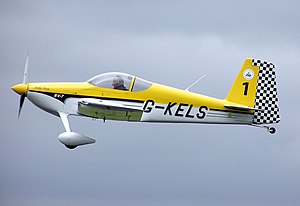avia.wikisort.org - Aeroplane
The Van's RV-7 and RV-7A are two-seat, single-engine, low-wing homebuilt airplanes sold in kit form by Van's Aircraft. The RV-7 is the tail-wheel equipped version, while the RV-7A features a nose-wheel.[4]
| RV-7 | |
|---|---|
 | |
| Role | RV-7 |
| Manufacturer | Van's Aircraft |
| Designer | Richard VanGrunsven |
| First flight | 2001[1] |
| Introduction | Early 2001[2] |
| Number built | 1909 (November 2022)[3] |
| Developed from | Van's Aircraft RV-6 |



The RV-7 was the replacement of the RV-6, replacing the RV-6 in 2001.[5] It is externally similar to the earlier model, with longer wings, larger fuel tanks and a larger rudder to improve spin recovery characteristics.[6]
Development
Van's aircraft designer Richard VanGrunsven designed the RV-7 to replace the RV-6, which was a two-seat side-by-side development of the RV-4. In turn, this was a two-seat version of the single seat RV-3.[7]
The RV-7 incorporated many changes resulting from the lessons learned in producing over 2,000 RV-6 kits. The RV-7 airframe will accept larger engines, including the Lycoming IO-390, up to 210 hp (157 kW).[8] The RV-7 also has increased wingspan and wing area over the RV-6, as well as more headroom, legroom and an increased useful load. The RV-7 carries a total of 42 US gallons (159 litres) of fuel, up from 38 US gallons (144 litres) on the RV-6.[7]
The RV-7 shares many common parts with the RV-8 and RV-9, which reduces production costs. The RV-7 has a computer-assisted design with pre-punched rivet holes, helping to keep assembly time to about 1500 hours for the average builder.[9]
The RV-7A version features a hardened, solid steel nose-wheel strut that fits into a tube welded to the engine mount. As in all nose-wheel equipped RV aircraft, the nose-wheel is free castering and the aircraft is steered with differential braking, or rudder at higher taxi speeds. The brakes are conventional toe brakes.
As of November 2022, 1,909 RV-7s and RV-7As had been flown.[3]
Specifications (RV-7)
Specifications are given for 200 hp, IO-360 configuration with a Hartzell constant speed propeller
General characteristics
- Crew: one pilot
- Capacity: one passenger
- Length: 20 ft 4 in (6.20 m)
- Wingspan: 25 ft (7.6 m)
- Height: 5 ft 10 in (1.79 m)
- Wing area: 121 sq ft (11.2 m2)
- Empty weight: 1,114 lb (505 kg)
- Gross weight: 1,800 lb (816 kg)
- Max takeoff weight: 1,800 lb (816 kg)
- Powerplant: 1 × Lycoming O-320, Lycoming O-360 or Lycoming IO-390 constant speed or fixed pitch, 160 to 210 hp (120 to 160 kW)
Performance
- Maximum speed: 217 mph (349 km/h, 189 kn) at sea level
- Cruise speed: 207 mph (333 km/h, 180 kn)
- Stall speed: 51 mph (82 km/h, 44 kn)
- Never exceed speed: 230 mph (370 km/h, 200 kn)
- Range: 765 mi (1,231 km, 665 nmi) at cruise 75% power at 8,000 ft (2,500 m)
- Service ceiling: 22,500 ft (6,900 m)
- Rate of climb: 1,900 ft/min (9.7 m/s)
- Wing loading: 14.8 lb/sq ft (72 kg/m2)
See also
Related development
Aircraft of comparable role, configuration, and era
References
- Van's Aircraft (2008). "Introduction – About RV Kitplanes". Archived from the original on March 9, 2012. Retrieved September 21, 2008.
- Van's Aircraft. "Making the Decision - Kit Prices / Lead Times". vansaircraft.com. Archived from the original on March 30, 2001. Retrieved March 27, 2021.
- Vans Aircraft (November 2022). "First Flights". Retrieved April 28, 2022.
- Vandermeullen, Richard: 2011 Kit Aircraft Buyer's Guide, Kitplanes, Volume 28, Number 12, December 2011, page 74. Belvoir Publications. ISSN 0891-1851
- Vans Aircraft (April 2019). "Van's RV-6 / 6A". Retrieved April 13, 2019.
- Vans Aircraft (June 2002). "Service Bulletin SB02-6-1" (PDF). Retrieved August 4, 2013.
- Bayerl, Robby; Martin Berkemeier; et al: World Directory of Leisure Aviation 2011–12, page 125. WDLA UK, Lancaster UK, 2011. ISSN 1368-485X
- "Van's RV-7". Van's Aircraft. Retrieved September 27, 2020.
- Kitplanes Staff: 2008 Kit Aircraft Directory, page 77, Kitplanes Magazine December 2007 Volume 24, Number 12, Belvior Publications, Aviation Publishing Group LLC.
External links
На других языках
- [en] Van's Aircraft RV-7
[fr] Van's Aircraft RV-7
Le Van’s Aircraft RV-7 est un avion biplace de sport et de voltige destiné à la construction amateur à partir de kits (Lots matières dans la terminologie DGAC) commercialisés par la société Van's Aircraft.Другой контент может иметь иную лицензию. Перед использованием материалов сайта WikiSort.org внимательно изучите правила лицензирования конкретных элементов наполнения сайта.
WikiSort.org - проект по пересортировке и дополнению контента Википедии